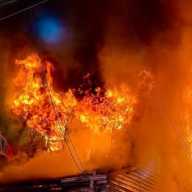New York City FC (NYCFC) broke ground on its new stadium in Willets Point Wednesday afternoon
The 25,000-seater stadium, which will be named Etihad Park, is scheduled to be completed before the start of the 2027 MLS season and will be the first-ever soccer-specific stadium in the five boroughs of New York City. The site is located across the street from the Citi Field bullpen along Seaver Way in Willets Point.
Once completed, the stadium will also be the first fully electric stadium in the United States.
New York City Council approved plans for the Willets Point project in April, which also includes plans for a 2,500-unit affordable housing complex, a 650-seat elementary school, a 250-room hotel, retail space and 40,000 square feet of public open space.
NYCFC is financing the entire project, with the stadium anticipated to cost around $800 million.

Wednesday’s groundbreaking marks a significant step in NYCFC’s search for a permanent home. The club, which was founded in 2013 and played its first MLS game in 2015, currently splits the majority of its home games between Citi Field and Yankee Stadium, depending on the schedules of the Mets and the Yankees. NYCFC also plays some home games at the home of their cross-town rivals the New York Red Bulls when neither Citi Field nor Yankee Stadium are available.
New York City Mayor Eric Adams, Queens Borough Donovan Richards, Council Member Francisco Moya, MLS Commissioner Don Gerber, EDC CEO Andrew Kimball and numerous city and NYCFC officials attended Wednesday’s groundbreaking.

Moya, who was born and raised in Corona, led the charge in the City Council to bring the city’s first-ever soccer-specific stadium to Willets Point and spoke on Wednesday about how he grew up playing soccer in Flushing Meadows-Corona Park and dreaming of bringing professional soccer to Queens.
“From the moment that I was elected, I knew that I was going to bring a soccer stadium to Queens,” Moya said at Wednesday’s groundbreaking. “I knew that it needed to be built alongside affordable housing. I knew that it needed to be built 100% union. I knew that it needed to be for the community, by the community.”
Elected officials said Wednesday that the Willets Point development will create around 14,000 construction jobs and 1,500 permanent jobs, all of which will be fully unionized.
Adams, meanwhile, said the development will create $6.1 billion in economic development over the next 30 years.
The Mayor described the Willets Point development as a “once in a generation historic achievement” and praised Moya for his efforts in fighting for the project in the City Council.
“This is a legacy project,” Adams said. “We cannot thank him enough.”

Gerber said the stadium would capture the hearts and minds of the people of New York City and described the groundbreaking of one of the most exciting days in his 25 years as MLS Commissioner.
“I grew up in Flushing and never in my life did I think I’d be standing here in my literal backyard,” Gerber said. “The world’s game is going to be played here in the world’s borough, and it absolutely one of the most exciting things for me in my 25 years as the commissioner of Major League Soccer.”
Several elected officials remarked Wednesday that the development enabled Willets Points to cast off the “Valley of Ashes” nickname it has borne for almost a century, a nickname first bestowed on the neighborhood by F. Scott Fitzgerald in “The Great Gatsby”.
Richards said Wednesday that the development enabled a brand new community to rise out of the “Valley of Ashes”.
“I don’t know about you, but I do not see any ashes today,” Richards said. “I see the makings of 2,500 new homes, the city’s largest 100% affordable housing development in 40 years. I see Etihad Park, the future home of New York City Football Club. I see the makings of a hotel, a school, three acres of open community space and more.”
Richards added that the project will be offering jobs to workers in Northern Queens and migrant and women-owned businesses (MBWE), expressing his hope that the new stadium will be available to the local community when it is not being used by NYCFC.
Jonathan Stemp, chief of infrastracture at City Football Group, which owns a majority stake in NYCFC, said Wednesday’s groundbreaking was the result of a collective resilience and hard work from numerous city officials and NYCFC employees.
Stemp said the Willets Point stadium will be a “special place” for NYCFC supporters and all New Yorkers.
“Children, fathers, grandfathers, daughters, wives, grandmothers will be coming to this stadium for generations, and they’re going to build stories together. They’re going to make it a very special place where they’re going to build memories,” Stemp said.
NYCFC supporters warmly welcomed the long-anticipated groundbreaking, stating that the development marks an exciting time for the club.
Felix Palau, president of the Bronx Chapter of the Third Rail supporters club, said the stadium is a reminder that the club’s roots are firmly planted in the five boroughs and added that the groundbreaking was something of a tonic following NYCFC’s defeat to the Red Bulls in the MLS Play-offs last month.
“It means that we finally have a home,” Palau said. “It means we did something that the Red Bulls couldn’t do, which is get a stadium without leaving the five boroughs.”
Mario Noreña, a founding member of the Third Rail and a Jackson Heights resident, described the groundbreaking as gratifying, emotional and special. Noreña said it was critical that the permanent home of NYCFC was developed within the five boroughs.
“I’m old enough to remember the Metro Stars when they started, and I was taken to one or two games, but I’m like, ‘we’re going to Jersey, that’s not New York.”
Although the stadium is still anticipated to open for the 2027 season, there have already been delays to the development. NYCFC Sporting Director David Lee told QNS in July that the groundbreaking was due to take place in early fall, while Stemp said after Wednesday’s groundbreaking ceremony that the progress of the development depends on a number of factors.
“The cold weather really does impact our ability to progress,” Stemp said. “We’ve got a super building team. We’re working hard… but what we want to do is make sure it’s built right because it’s going to be here for anywhere between 50 and 75 years. So we need to make sure that it’s built right, it’s safe and that it lasts. Therefore, quality is more important than speed.”

































